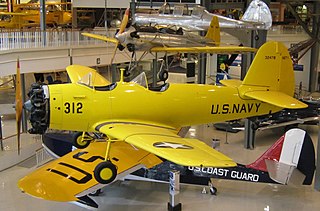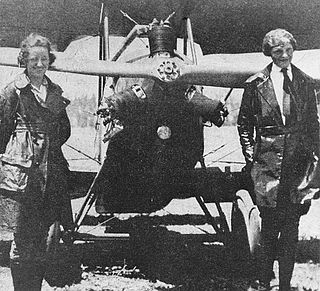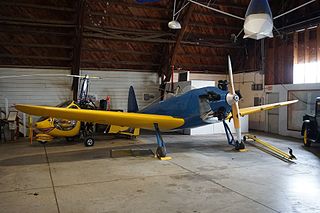Related Research Articles

The Monocoupe 90 was a two-seat, light cabin airplane built by Donald A. Luscombe for Monocoupe Aircraft. The first Monocoupe was built in an abandoned church in Davenport, Iowa, and first flew on April 1, 1927. Various models were in production until the late 1940s.

The Arrow Sport is a two-seat sporting biplane aircraft built in the United States in the 1920s and 1930s.

The Culver Dart was a 1930s American two-seat light monoplane aircraft produced by the Dart Aircraft Company.

The Cessna Model A is a 1920s American high-wing four-seat tourer built by the Cessna Aircraft Company, the first in a long line of high-wing single-engined monoplanes.

The Kinner Sportwing was a 1930s American light monoplane built by Kinner Airplane & Motor Corporation.

The Kinner R Playboy was a 1930s American two-seat sporting monoplane built by Kinner Airplane & Motor Corporation.

The Timm N2T Tutor is an American training monoplane built by the Timm Aircraft Corporation for the United States Navy as the N2T-1.

The Bullet Monoplane or Alexander Eaglerock Bullet was a low wing cabin monoplane that was a departure from traditional biplane aircraft of the era.

The Kreider-Reisner KR-21-A is a 1928 American two-seat biplane. It was designed and built by the Kreider-Reisner Aircraft Company of Hagerstown, Maryland. Fairchild Aircraft took over Kreider-Reisner in 1929 and continued to build them, as the Fairchild KR-21, later the Fairchild 21.
The Security Airster S-1 is an American two-seat single-engined monoplane designed by Bert Kinner and built by his Security National Aircraft Corporation later named the American Aircraft Corporation.

The Kinner Airster is an American two-seat single-engined biplane designed by Bert Kinner and built by his Kinner Airplane & Motor Corporation.

The Mohawk M1C was a 1920s American two or three-seat low-wing monoplane designed and built by Mohawk Aero Corporation of Minneapolis, Minnesota. One M1C was evaluated by the United States Army Air Corps in 1930 as the YPT-7 Pinto for use as a primary trainer.

The Pasped W-1 Skylark is a 1930s American two-seat single-engined cabin monoplane designed and built by the Pasped Aircraft Company of Glendale, California.

The Howard DGA-18 was an American two-seat basic training aircraft designed and built by the Howard Aircraft Corporation for the United States Civil Pilot Training Program.
The St. Louis C2 Cardinal family are a series of light sport monoplanes built by the St. Louis Aircraft Corporation during the peak of the Lindbergh Boom after the Spirit of St. Louis flight of 1927.

The Loening XSL was an American submarine-based reconnaissance flying boat designed and built by Grover Loening Aircraft Company for the United States Navy.
The Redfern DH-2 is an American homebuilt aircraft that was designed by Walter Redfern and produced by the Walter Redfern Company of Post Falls, Idaho, based upon the 1915 Airco DH.2 fighter aircraft. When it was available the aircraft was supplied in the form of plans for amateur construction.

The Lincoln AP was a U.S., single engine, high wing, general purpose civil cabin aircraft first flown in 1930. Only four were built.
The Waterman Flex-Wing was a four seat cabin aircraft designed to be easy for non-expert pilots to fly. Its principle safety features were based on a hinged wing providing controllable and interconnected dihedral and incidence. Two were built but the absence of funding in the difficult trading conditions of the Great Depression ended the project.
The States Super Monoplane was a tandem two seat, civil sport and trainer aircraft built in small numbers at the start of the U.S Great Depression.
References
Notes
- ↑ John Underwood (Winter 1969). "The Quiet Professor". Air Progress Sport Aircraft.
- ↑ Eckland, K.O. (2008-08-15). "American airplanes: Kinner". Aerofiles.com. Retrieved 2011-02-12.
Bibliography
- The Illustrated Encyclopedia of Aircraft (Part Work 1982–1985). Orbis Publishing.